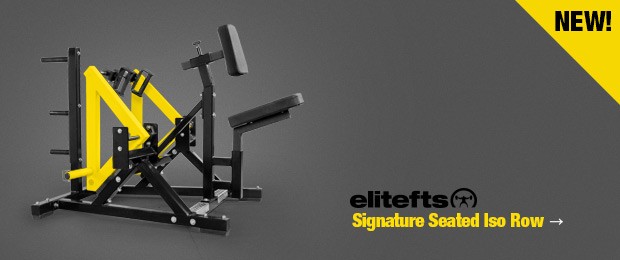
Train your back everyday you’re in the gym. Coaches all over the world complain about the poor posture and lack of posterior chain of their athletes. So why not attack part of that weakness every time you train? When I see a lack of back training in programming, you can almost be sure there will be high rates of shoulder problems as well. You want function? Get your back strong. Don’t worry about over-training the back. Most of the muscles we’re talking about are postural, so they are always working and very hard to over-train. If we couple this fact with good programming and rotation of exercises, we’re on our way to better performance and become more durable athletes. If nothing else, a thick wide back can help you hide that power gut you’ve got going from your bulk phase that started in 1996… from the back, at least.
Back Training Rules
In our version of the Conjugate model, there were a couple of rules we liked to follow the majority of the time.
Rule 1: On upper body days, pull in a plane that is somewhat perpendicular to the torso. So basically, do a horizontal row.
Rule 2: On lower body days, do a vertical pulling motion to help traction out the spine that you just spent the last 45 minutes compressing. Get stronger while implementing traction.
Rule 3: Use higher taxing movements on Max Effort Days and movements with lower neurological cost on Dynamic Effort or Speed Days. Again, recovery built into the programs… maybe this is how we put thousands of drug-free natty athletes through the system that only super gassed up powerlifters and old Soviet Olympic athletes could survive and decreased overall injury rates while doing so?! But who really knows, right!
Rule 4: Learn static scapular depression and retraction during rowing movements (usually four weeks for newbs) then start programming in scapular mobility into the rows. Do approximately half of your movements with static scapula and the other half letting the scapula elevate and protract during the eccentric to get more of a stretch in the movement. When using the mobile scap method, you have to start the concentric by depressing and retracting the scapula.
Rule 5: Generally, try to add a set each week. This way we are increasing work capacity but waving volumes so we can adapt and recover. Week One would typically be three sets, and by week three, we would be up to five or six sets, then start over on Week One again.
Within each movement variation, there are more options for forcing different training adaptations, so this multiplies the amount of options we have even further. Over the past few months some things that have made a big difference in my own training have been:
- Paused reps at my chest/stomach
- Slow eccentrics
- Scap movement with rowing motion
- Handle/grip variation
As you can see, you just multiplied each movement variation four times with the addition of those variables. The pauses and slow eccentrics have made the most impact personally as of late. These are some factors I think coaches often overlook — I know I did for years.
Below are some rowing variations sorted into the proper training days to follow our model.
Max Upper Variations
Ramp Rows
These will wreck you every time.
Put the short end of the spotter pins in the rack at about waist height, then rotate them down so they are against the bottom of the rack and the floor.
Start standing up, then lower yourself down into an RDL position. Arch up hard when you row and let your shoulder blades roll out when the bar goes down the ramp.
3-6 x 6-20
One-arm Dumbbell Row on Bench
Row the dumbbell to your stomach and suck the shoulder blade back as you row. Straighten your elbow out each rep.
3-6 x 6-20
Chest-supported Cambered Bar Row
There is a good amount of set up on this one. This usually stayed in place for a couple of week s for that reason.
Elevate a utility bench. You have to use a cambered bar to get the correct ROM. On the concentric, drive your elbows back and squeeze your shoulder blades together as hard as you can. In the eccentric, control the weight down and let your shoulder blades spread apart and stretch. Not being able to pull with your legs and low back like on a T-bar row makes these brutally hard. Another great variation is to drape some gains across the bar. To make these even harder, pause each rep at the top while pulling the bar into the bench.
3-8 x 6-20
Bent Two-arm Dumbbell Row
Place a dumbbell in each hand and lower yourself into an RDL position. Keep your back flat (parallel with the floor) the entire movement. Row the dumbbells to your stomach. Keep your shoulder blades retracted on this movement.
3-6 x 6-12
Chest-support Dumbbell Row
Speed Lower Variations
Vogelpulls
Step back and get your feet set with your weight back in your heels and hips. When you extend your arms out, let everything stretch. Pull the weight back without any momentum. As the handles get closer to your arch up a little and contact your back while squeezing your elbows back. The slower tempo makes these brutal.
3-6 x 10-20
High Cross Body Scap Row
Hook a band on top of a rack. In the start position, let your shoulder blade pull out away from your spine and get a stretch between the shoulder blade and spine. To start the row, suck your shoulder blade down and back (put it in your opposite back pocket) then keep pulling your elbow back and hold the contraction for a second.
Pull-downs
Speed Upper Variations
Inverted Rows (Vary Grips):
Keep a straight line from your shoulders to your ankles. Pull up until your stomach/chest is touching the bar, then lower your body until your arms are straight again.
Alternating Banded Rows
Start with both hands back. Let one arm out, pull it back, and then repeat with the other. This is great for increasing time under tension because the athlete has to keep the paused arm isometric contraction while the other arm is rowing.
You can do sets and reps of 3-6x 6-12 or do sets for time. Just make it suck. That’s the secret to most accessory work: do work. If it’s easy, find a way to make it harder.
Low Cross Body Scap Rows
Hook a band on the bottom of a rack. In the start position, let your shoulder blade pull out away from your spine and get a stretch between the shoulder blade and spine. To start the row, suck your shoulder blade down and back (put it in your opposite back pocket) then keep pulling your elbow back, hold the contraction for a second.
Max Lower Variations
Lucifer Pull-ups
Six reps each handle equals one set, no rest. Use good pull-up form as best you can.
Chin-ups
Straighten your elbow after each rep, cheater! Throw a chain on your shoulders to make these harder.
Pull-ups
Straighten your elbow after each rep cheater! Throw a chain on your shoulders to make these harder. Vary the grip weekly. Close Grip, Wide Grip, Neutral Grip, Close Grip Neutral Grip, Wide Grip Neutral Grip. You’ve got five weeks worth of programming right there.











You can get a similar or maybe even better effect with the trap bar or hex deadlift bar or whatever we're callingt hem now. See them in normie gyms a lot nowadays. The handles are up a few inches so it creates the room you need for ROM, and the nuetral grip is arguably better than a straight cambered, or at least a variation.